Management Accounting, Planning Tools and Financial Problems at Zylla
VerifiedAdded on 2024/06/04
|18
|3989
|398
Report
AI Summary
This report serves as a management accounting analysis for Zylla Company, addressing various aspects of the company's financial management and reporting systems. It explains management accounting, detailing essential requirements and methods used for reporting. The report calculates costs using techniques like marginal and absorption costing to prepare income statements and applies various management accounting techniques to produce financial reporting documents. It also analyzes planning tools used in budgetary control and how organizations adapt management accounting systems to respond to financial problems, ultimately aiming for sustainable success. The document provides insights into the integration of management accounting systems within organizational processes and the critical evaluation of planning tools for addressing financial challenges.
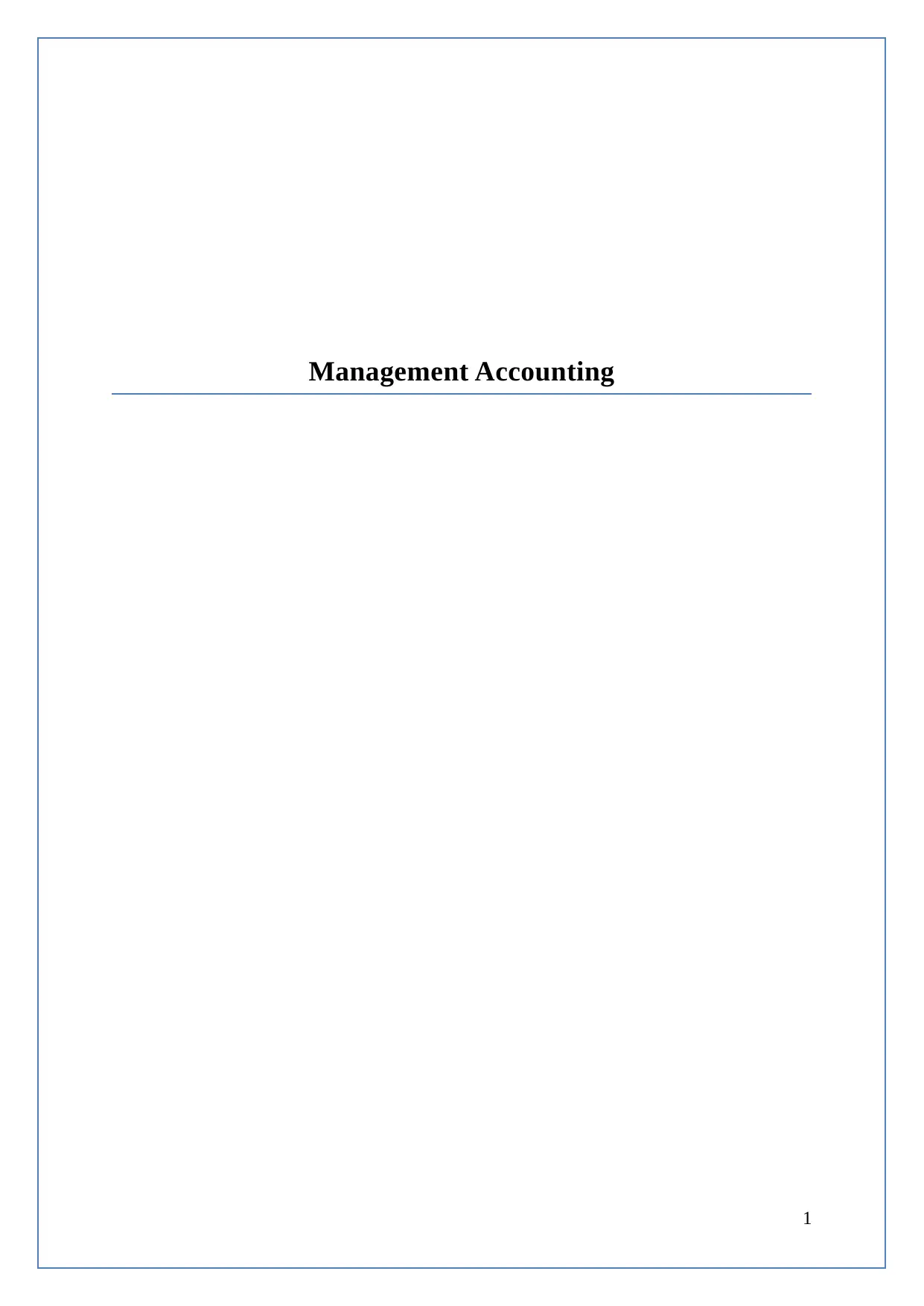
Management Accounting
1
1
Paraphrase This Document
Need a fresh take? Get an instant paraphrase of this document with our AI Paraphraser
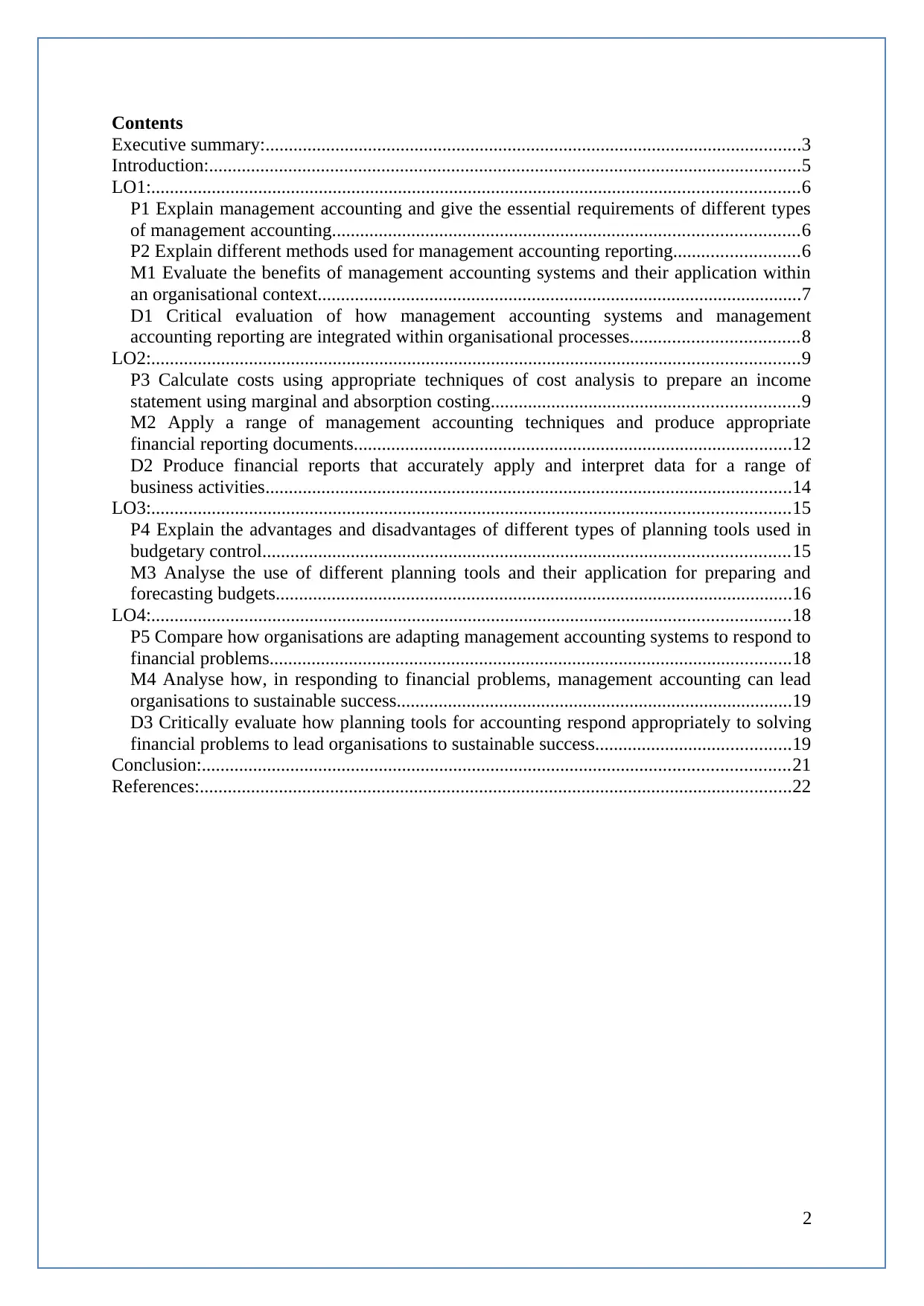
Contents
Executive summary:...................................................................................................................3
Introduction:...............................................................................................................................5
LO1:...........................................................................................................................................6
P1 Explain management accounting and give the essential requirements of different types
of management accounting....................................................................................................6
P2 Explain different methods used for management accounting reporting...........................6
M1 Evaluate the benefits of management accounting systems and their application within
an organisational context........................................................................................................7
D1 Critical evaluation of how management accounting systems and management
accounting reporting are integrated within organisational processes....................................8
LO2:...........................................................................................................................................9
P3 Calculate costs using appropriate techniques of cost analysis to prepare an income
statement using marginal and absorption costing..................................................................9
M2 Apply a range of management accounting techniques and produce appropriate
financial reporting documents..............................................................................................12
D2 Produce financial reports that accurately apply and interpret data for a range of
business activities.................................................................................................................14
LO3:.........................................................................................................................................15
P4 Explain the advantages and disadvantages of different types of planning tools used in
budgetary control.................................................................................................................15
M3 Analyse the use of different planning tools and their application for preparing and
forecasting budgets...............................................................................................................16
LO4:.........................................................................................................................................18
P5 Compare how organisations are adapting management accounting systems to respond to
financial problems................................................................................................................18
M4 Analyse how, in responding to financial problems, management accounting can lead
organisations to sustainable success.....................................................................................19
D3 Critically evaluate how planning tools for accounting respond appropriately to solving
financial problems to lead organisations to sustainable success..........................................19
Conclusion:..............................................................................................................................21
References:...............................................................................................................................22
2
Executive summary:...................................................................................................................3
Introduction:...............................................................................................................................5
LO1:...........................................................................................................................................6
P1 Explain management accounting and give the essential requirements of different types
of management accounting....................................................................................................6
P2 Explain different methods used for management accounting reporting...........................6
M1 Evaluate the benefits of management accounting systems and their application within
an organisational context........................................................................................................7
D1 Critical evaluation of how management accounting systems and management
accounting reporting are integrated within organisational processes....................................8
LO2:...........................................................................................................................................9
P3 Calculate costs using appropriate techniques of cost analysis to prepare an income
statement using marginal and absorption costing..................................................................9
M2 Apply a range of management accounting techniques and produce appropriate
financial reporting documents..............................................................................................12
D2 Produce financial reports that accurately apply and interpret data for a range of
business activities.................................................................................................................14
LO3:.........................................................................................................................................15
P4 Explain the advantages and disadvantages of different types of planning tools used in
budgetary control.................................................................................................................15
M3 Analyse the use of different planning tools and their application for preparing and
forecasting budgets...............................................................................................................16
LO4:.........................................................................................................................................18
P5 Compare how organisations are adapting management accounting systems to respond to
financial problems................................................................................................................18
M4 Analyse how, in responding to financial problems, management accounting can lead
organisations to sustainable success.....................................................................................19
D3 Critically evaluate how planning tools for accounting respond appropriately to solving
financial problems to lead organisations to sustainable success..........................................19
Conclusion:..............................................................................................................................21
References:...............................................................................................................................22
2
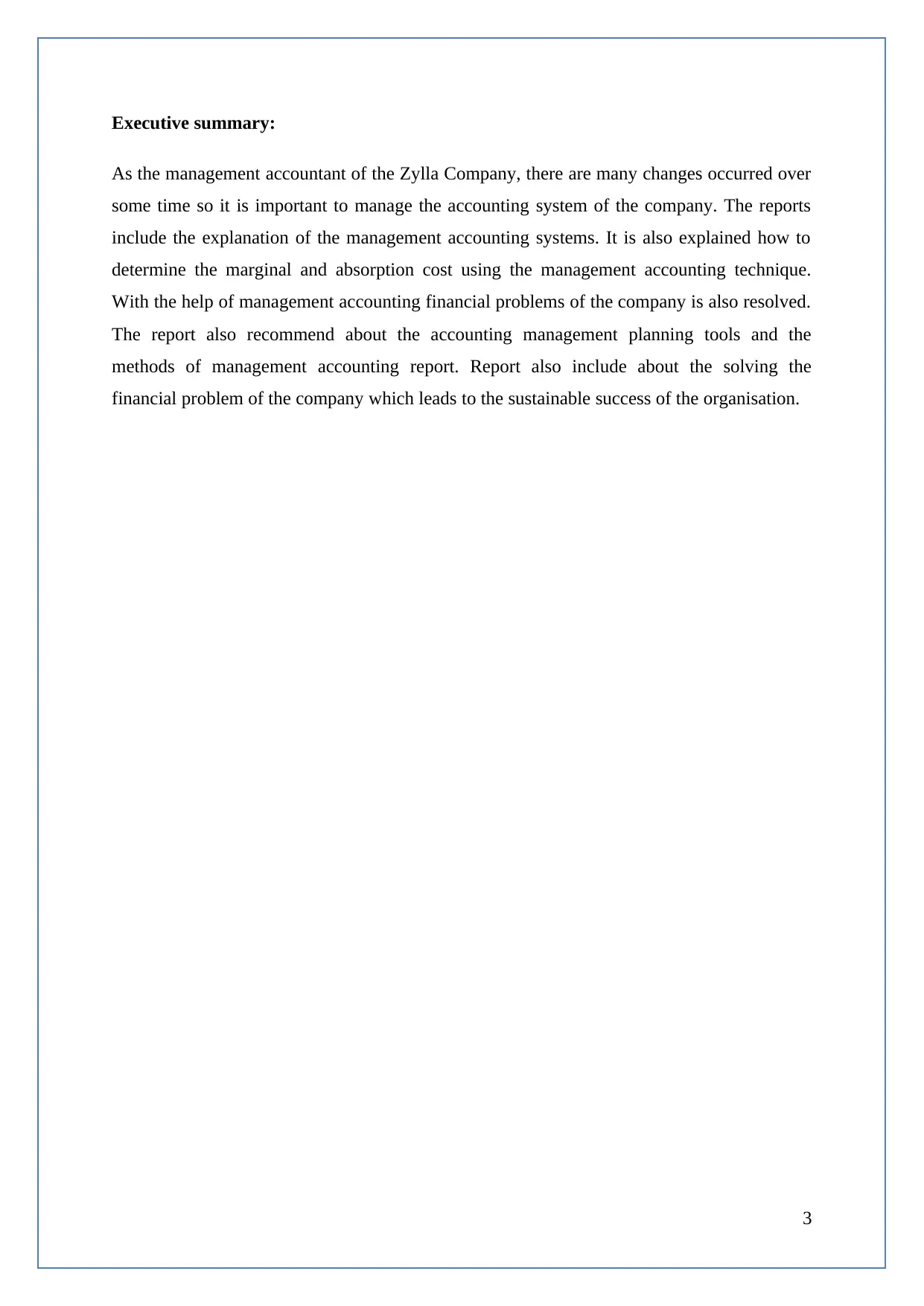
Executive summary:
As the management accountant of the Zylla Company, there are many changes occurred over
some time so it is important to manage the accounting system of the company. The reports
include the explanation of the management accounting systems. It is also explained how to
determine the marginal and absorption cost using the management accounting technique.
With the help of management accounting financial problems of the company is also resolved.
The report also recommend about the accounting management planning tools and the
methods of management accounting report. Report also include about the solving the
financial problem of the company which leads to the sustainable success of the organisation.
3
As the management accountant of the Zylla Company, there are many changes occurred over
some time so it is important to manage the accounting system of the company. The reports
include the explanation of the management accounting systems. It is also explained how to
determine the marginal and absorption cost using the management accounting technique.
With the help of management accounting financial problems of the company is also resolved.
The report also recommend about the accounting management planning tools and the
methods of management accounting report. Report also include about the solving the
financial problem of the company which leads to the sustainable success of the organisation.
3
⊘ This is a preview!⊘
Do you want full access?
Subscribe today to unlock all pages.

Trusted by 1+ million students worldwide
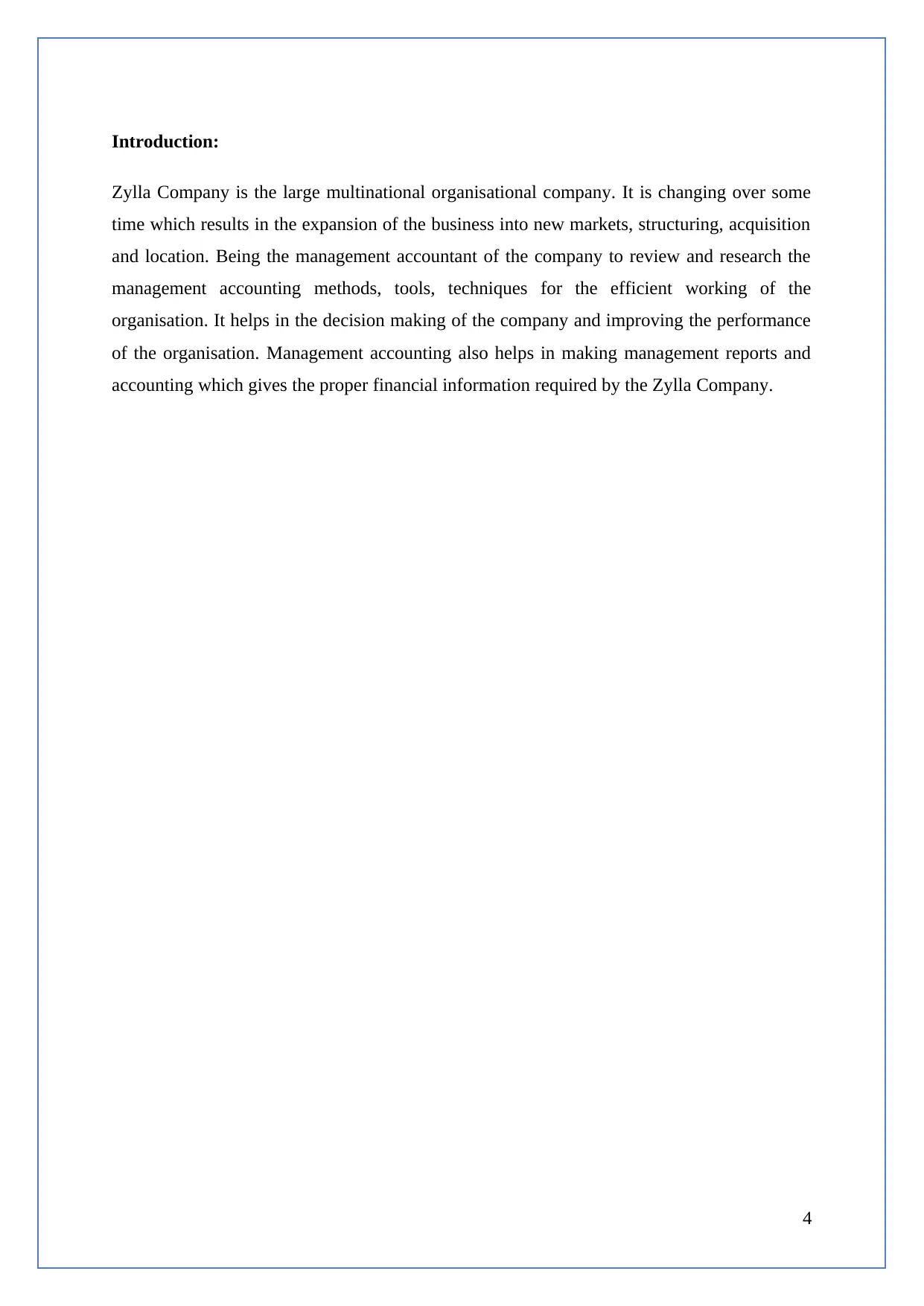
Introduction:
Zylla Company is the large multinational organisational company. It is changing over some
time which results in the expansion of the business into new markets, structuring, acquisition
and location. Being the management accountant of the company to review and research the
management accounting methods, tools, techniques for the efficient working of the
organisation. It helps in the decision making of the company and improving the performance
of the organisation. Management accounting also helps in making management reports and
accounting which gives the proper financial information required by the Zylla Company.
4
Zylla Company is the large multinational organisational company. It is changing over some
time which results in the expansion of the business into new markets, structuring, acquisition
and location. Being the management accountant of the company to review and research the
management accounting methods, tools, techniques for the efficient working of the
organisation. It helps in the decision making of the company and improving the performance
of the organisation. Management accounting also helps in making management reports and
accounting which gives the proper financial information required by the Zylla Company.
4
Paraphrase This Document
Need a fresh take? Get an instant paraphrase of this document with our AI Paraphraser

LO1:
P1 Explain management accounting and give the essential requirements of different
types of management accounting.
Management accounting helps in managing the business organisation. The manager manages
the business and takes the decisions for the better goals for the organisation. By managing the
reports of the company, we can accurately maintain the information of the company. It also
helps in taking the financial decisions of the company. It manages analyses, and predicting
the future. It helps in making the conclusion and predicting flows of cash. It makes the
performance of the company better and helps in achieving the goals of the organisation. It
helps in evaluating how sales of the company should be increase. For evaluation an
accounting manager can analyse the difference between advertising alternatives of each
product (McNeil, 2015).
P2 Explain different methods used for management accounting reporting.
There are different methods of management accounting such as:
1. Financial information: It helps in evaluating the ratios, comparative statement, graphs,
diagrams, trend, fun flows, and cash flows and also analyse the return on capital employed.
2. Cost accounting: It includes the information such as marginal costing, standard costing,
variances of cost, direct costing, etc. It also helps in analysing the profit, cost of the company
Zylla (McNeil, 2015).
3. Mathematical Approach: It helps in analysing the numerical as well as the operational
functioning of the organisation. It helps in programming the statistical data and also
achieving the objectives of the company (Bedford, 2015).
4. Budget: Budget is the forecast of the future planning; it helps in analysing the budget
variance and the revenue variance. Budgeting controls also manages the cash requirements of
the company. There are also the appraisal projects and the evaluation of the organisation
which leads to attain the performance of the company.
5 Financial statements and planning: The Company’s main objective is to attain a
maximum profit. It can only be attain by a proper financial planning, so it is the essential tool
5
P1 Explain management accounting and give the essential requirements of different
types of management accounting.
Management accounting helps in managing the business organisation. The manager manages
the business and takes the decisions for the better goals for the organisation. By managing the
reports of the company, we can accurately maintain the information of the company. It also
helps in taking the financial decisions of the company. It manages analyses, and predicting
the future. It helps in making the conclusion and predicting flows of cash. It makes the
performance of the company better and helps in achieving the goals of the organisation. It
helps in evaluating how sales of the company should be increase. For evaluation an
accounting manager can analyse the difference between advertising alternatives of each
product (McNeil, 2015).
P2 Explain different methods used for management accounting reporting.
There are different methods of management accounting such as:
1. Financial information: It helps in evaluating the ratios, comparative statement, graphs,
diagrams, trend, fun flows, and cash flows and also analyse the return on capital employed.
2. Cost accounting: It includes the information such as marginal costing, standard costing,
variances of cost, direct costing, etc. It also helps in analysing the profit, cost of the company
Zylla (McNeil, 2015).
3. Mathematical Approach: It helps in analysing the numerical as well as the operational
functioning of the organisation. It helps in programming the statistical data and also
achieving the objectives of the company (Bedford, 2015).
4. Budget: Budget is the forecast of the future planning; it helps in analysing the budget
variance and the revenue variance. Budgeting controls also manages the cash requirements of
the company. There are also the appraisal projects and the evaluation of the organisation
which leads to attain the performance of the company.
5 Financial statements and planning: The Company’s main objective is to attain a
maximum profit. It can only be attain by a proper financial planning, so it is the essential tool
5
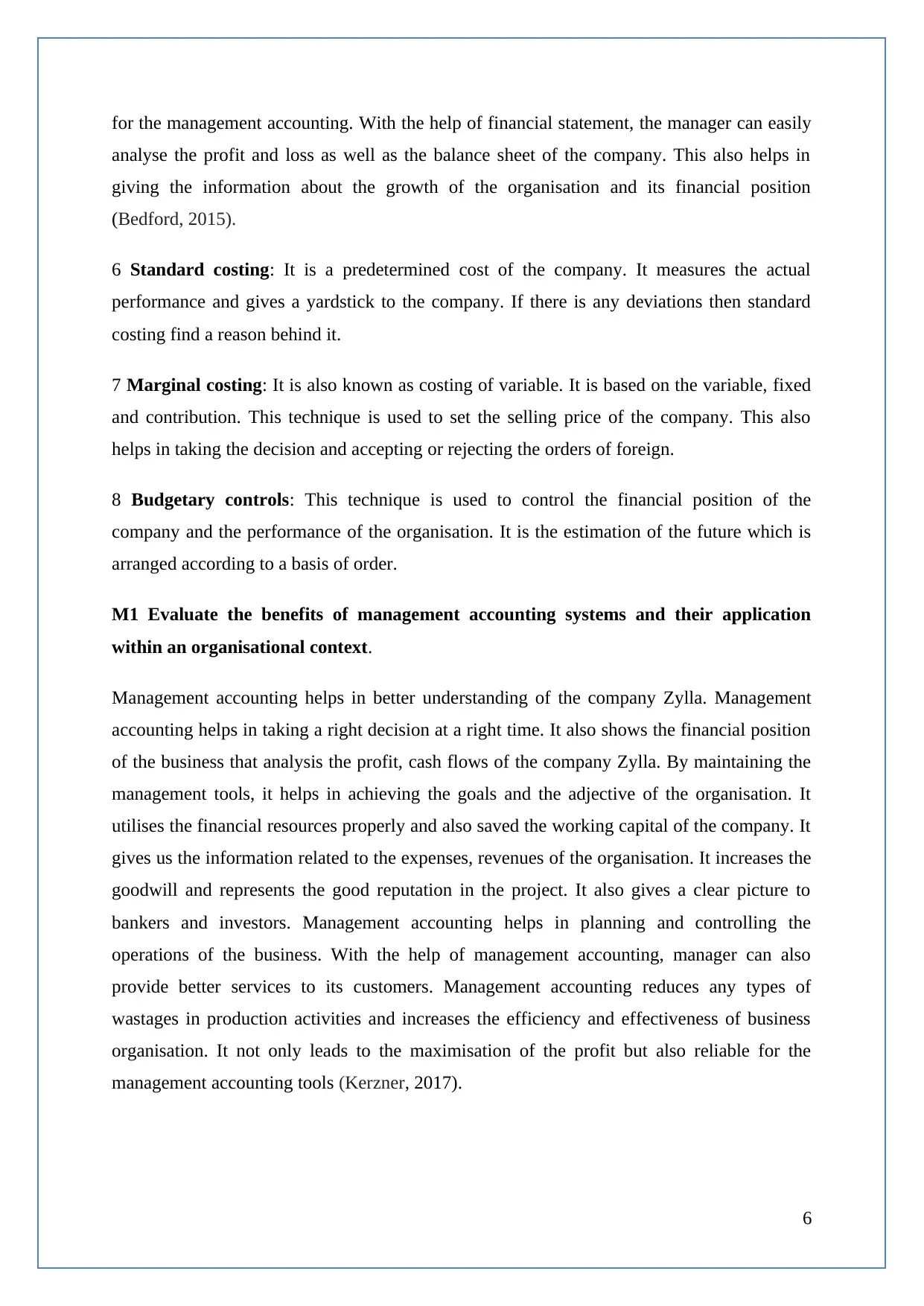
for the management accounting. With the help of financial statement, the manager can easily
analyse the profit and loss as well as the balance sheet of the company. This also helps in
giving the information about the growth of the organisation and its financial position
(Bedford, 2015).
6 Standard costing: It is a predetermined cost of the company. It measures the actual
performance and gives a yardstick to the company. If there is any deviations then standard
costing find a reason behind it.
7 Marginal costing: It is also known as costing of variable. It is based on the variable, fixed
and contribution. This technique is used to set the selling price of the company. This also
helps in taking the decision and accepting or rejecting the orders of foreign.
8 Budgetary controls: This technique is used to control the financial position of the
company and the performance of the organisation. It is the estimation of the future which is
arranged according to a basis of order.
M1 Evaluate the benefits of management accounting systems and their application
within an organisational context.
Management accounting helps in better understanding of the company Zylla. Management
accounting helps in taking a right decision at a right time. It also shows the financial position
of the business that analysis the profit, cash flows of the company Zylla. By maintaining the
management tools, it helps in achieving the goals and the adjective of the organisation. It
utilises the financial resources properly and also saved the working capital of the company. It
gives us the information related to the expenses, revenues of the organisation. It increases the
goodwill and represents the good reputation in the project. It also gives a clear picture to
bankers and investors. Management accounting helps in planning and controlling the
operations of the business. With the help of management accounting, manager can also
provide better services to its customers. Management accounting reduces any types of
wastages in production activities and increases the efficiency and effectiveness of business
organisation. It not only leads to the maximisation of the profit but also reliable for the
management accounting tools (Kerzner, 2017).
6
analyse the profit and loss as well as the balance sheet of the company. This also helps in
giving the information about the growth of the organisation and its financial position
(Bedford, 2015).
6 Standard costing: It is a predetermined cost of the company. It measures the actual
performance and gives a yardstick to the company. If there is any deviations then standard
costing find a reason behind it.
7 Marginal costing: It is also known as costing of variable. It is based on the variable, fixed
and contribution. This technique is used to set the selling price of the company. This also
helps in taking the decision and accepting or rejecting the orders of foreign.
8 Budgetary controls: This technique is used to control the financial position of the
company and the performance of the organisation. It is the estimation of the future which is
arranged according to a basis of order.
M1 Evaluate the benefits of management accounting systems and their application
within an organisational context.
Management accounting helps in better understanding of the company Zylla. Management
accounting helps in taking a right decision at a right time. It also shows the financial position
of the business that analysis the profit, cash flows of the company Zylla. By maintaining the
management tools, it helps in achieving the goals and the adjective of the organisation. It
utilises the financial resources properly and also saved the working capital of the company. It
gives us the information related to the expenses, revenues of the organisation. It increases the
goodwill and represents the good reputation in the project. It also gives a clear picture to
bankers and investors. Management accounting helps in planning and controlling the
operations of the business. With the help of management accounting, manager can also
provide better services to its customers. Management accounting reduces any types of
wastages in production activities and increases the efficiency and effectiveness of business
organisation. It not only leads to the maximisation of the profit but also reliable for the
management accounting tools (Kerzner, 2017).
6
⊘ This is a preview!⊘
Do you want full access?
Subscribe today to unlock all pages.

Trusted by 1+ million students worldwide

D1 Critical evaluation of how management accounting systems and management
accounting reporting are integrated within organisational processes.
There is a relationship between management accounting system and their processes which are
integrated with the business organisation. It helps in the effective working of the
organisation. Business strategies help in achieving the goals of the organisation. It also
controls and manages the accounting system of the company Zylla. With the help of
management accounting the organisation can easily run its processes. Management
accounting reports gives the picture of financial position of the company which also leads to
the sustainable success of the organisation. Management accounting also gives the statistical
database information which is very essential for the company. Management accounting helps
in taking the internal decision of the company and also leads to the effective control of the
organisation. Management accounting identifies all the activities of the company and solves
all the problems of the organisation. If management accounting works properly then only the
organisation can achieve the business goals and objectives. So it is necessary for every
organisation to adopt the accounting systems and accounting reports which helps in achieving
the organisational goals. Management accounting does planning of the company and
organising the activities and manages the overall performances of the organisation (Gitman,
2015).
7
accounting reporting are integrated within organisational processes.
There is a relationship between management accounting system and their processes which are
integrated with the business organisation. It helps in the effective working of the
organisation. Business strategies help in achieving the goals of the organisation. It also
controls and manages the accounting system of the company Zylla. With the help of
management accounting the organisation can easily run its processes. Management
accounting reports gives the picture of financial position of the company which also leads to
the sustainable success of the organisation. Management accounting also gives the statistical
database information which is very essential for the company. Management accounting helps
in taking the internal decision of the company and also leads to the effective control of the
organisation. Management accounting identifies all the activities of the company and solves
all the problems of the organisation. If management accounting works properly then only the
organisation can achieve the business goals and objectives. So it is necessary for every
organisation to adopt the accounting systems and accounting reports which helps in achieving
the organisational goals. Management accounting does planning of the company and
organising the activities and manages the overall performances of the organisation (Gitman,
2015).
7
Paraphrase This Document
Need a fresh take? Get an instant paraphrase of this document with our AI Paraphraser
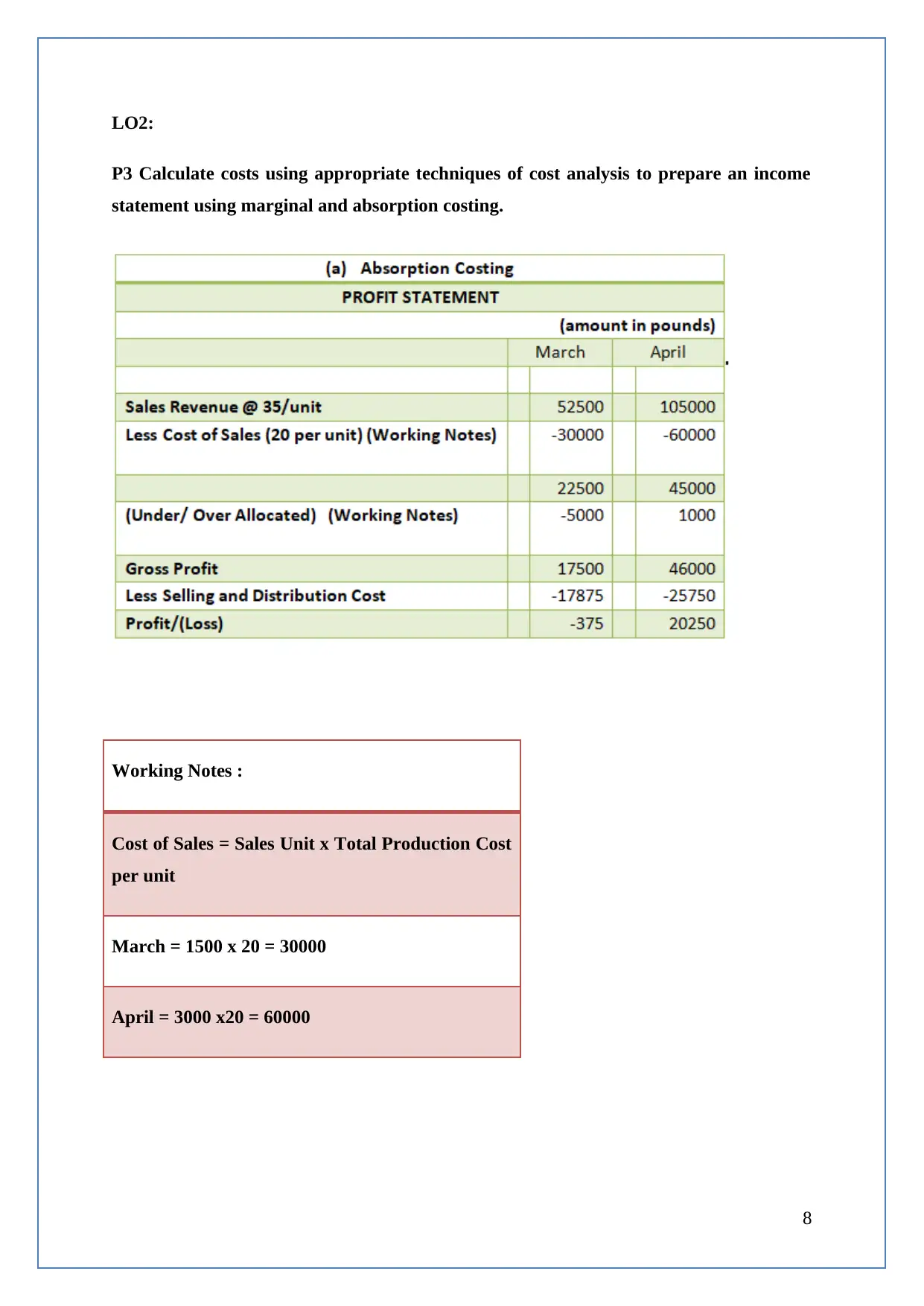
LO2:
P3 Calculate costs using appropriate techniques of cost analysis to prepare an income
statement using marginal and absorption costing.
Working Notes :
Cost of Sales = Sales Unit x Total Production Cost
per unit
March = 1500 x 20 = 30000
April = 3000 x20 = 60000
8
P3 Calculate costs using appropriate techniques of cost analysis to prepare an income
statement using marginal and absorption costing.
Working Notes :
Cost of Sales = Sales Unit x Total Production Cost
per unit
March = 1500 x 20 = 30000
April = 3000 x20 = 60000
8
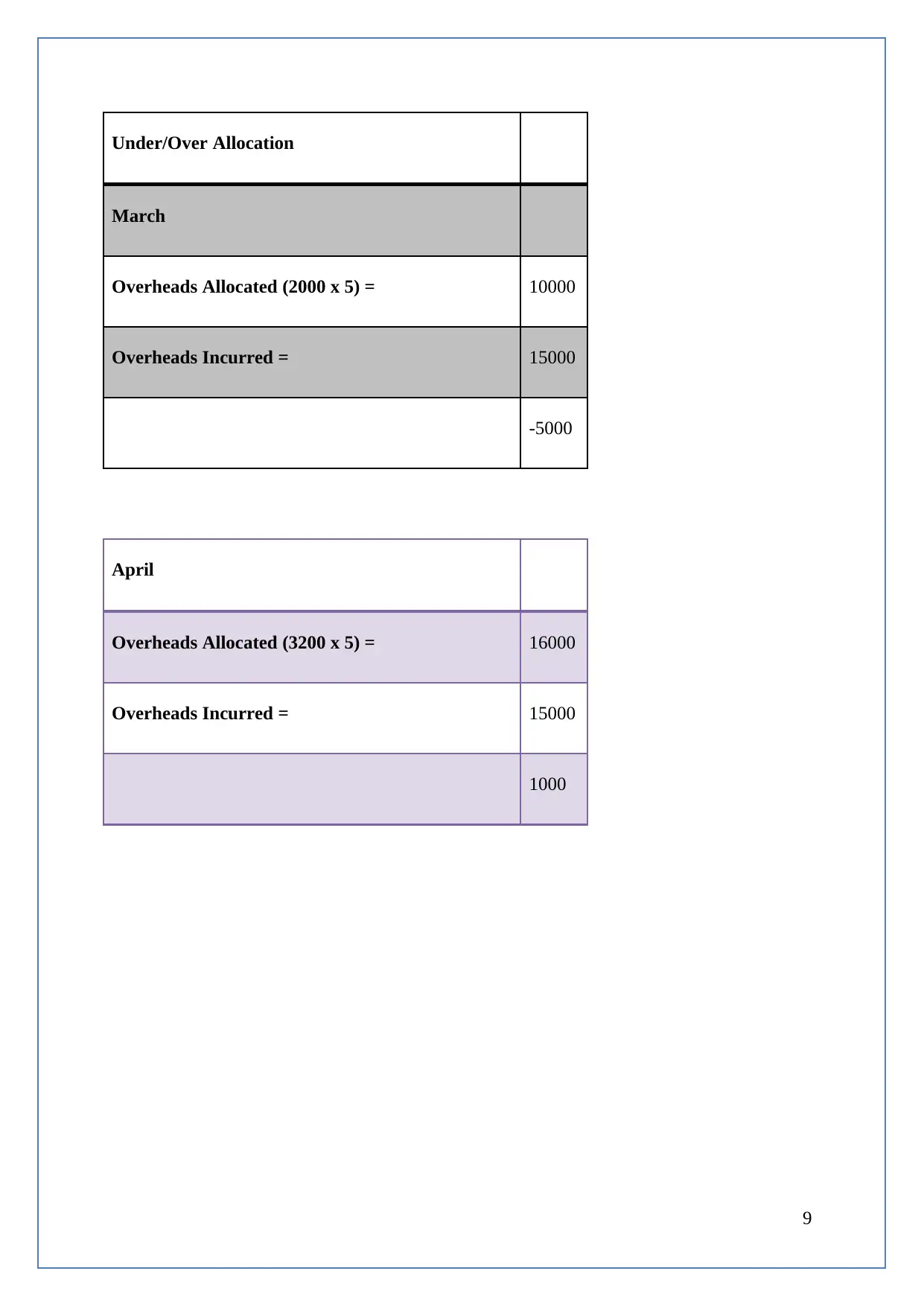
Under/Over Allocation
March
Overheads Allocated (2000 x 5) = 10000
Overheads Incurred = 15000
-5000
April
Overheads Allocated (3200 x 5) = 16000
Overheads Incurred = 15000
1000
9
March
Overheads Allocated (2000 x 5) = 10000
Overheads Incurred = 15000
-5000
April
Overheads Allocated (3200 x 5) = 16000
Overheads Incurred = 15000
1000
9
⊘ This is a preview!⊘
Do you want full access?
Subscribe today to unlock all pages.

Trusted by 1+ million students worldwide
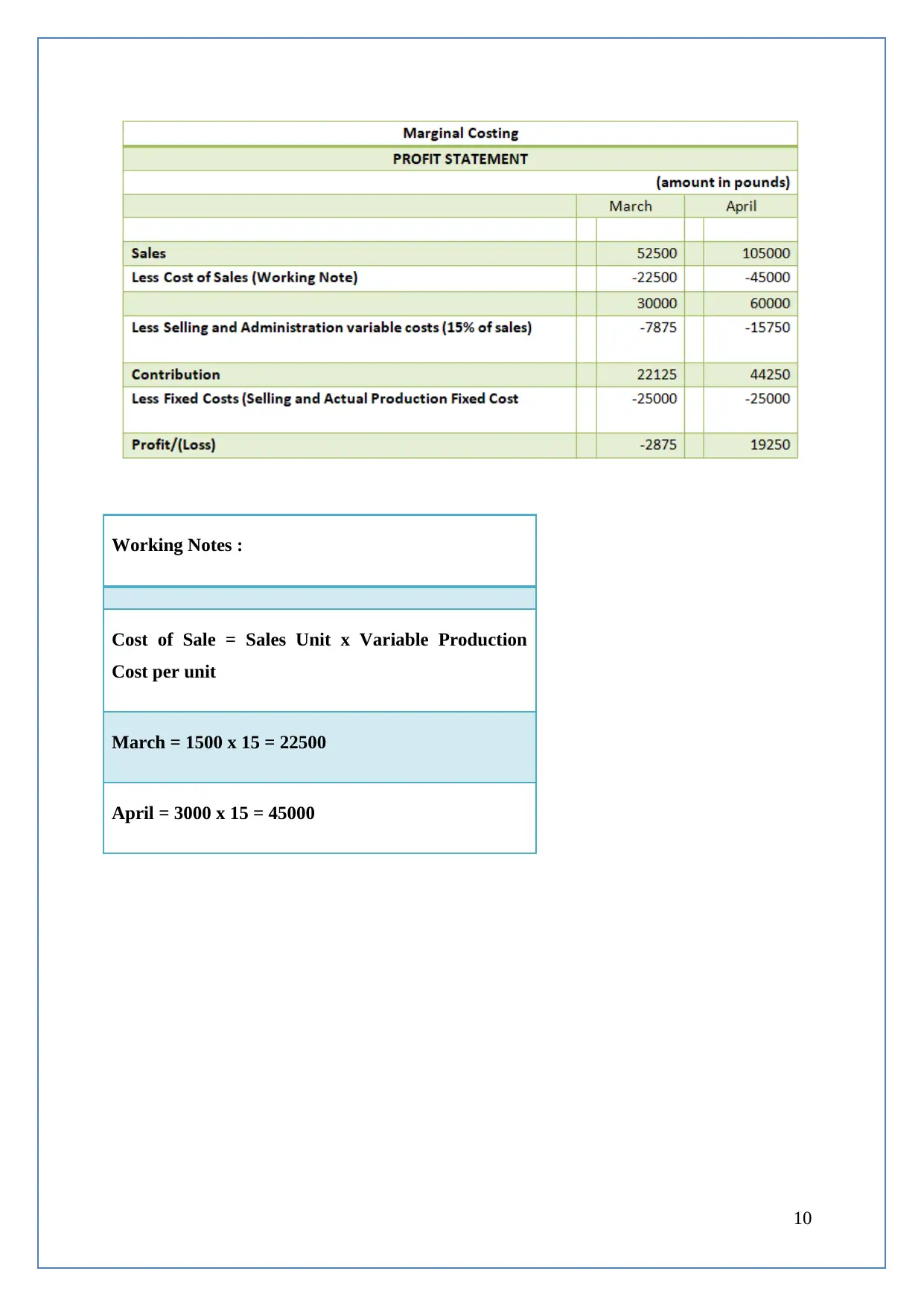
Working Notes :
Cost of Sale = Sales Unit x Variable Production
Cost per unit
March = 1500 x 15 = 22500
April = 3000 x 15 = 45000
10
Cost of Sale = Sales Unit x Variable Production
Cost per unit
March = 1500 x 15 = 22500
April = 3000 x 15 = 45000
10
Paraphrase This Document
Need a fresh take? Get an instant paraphrase of this document with our AI Paraphraser
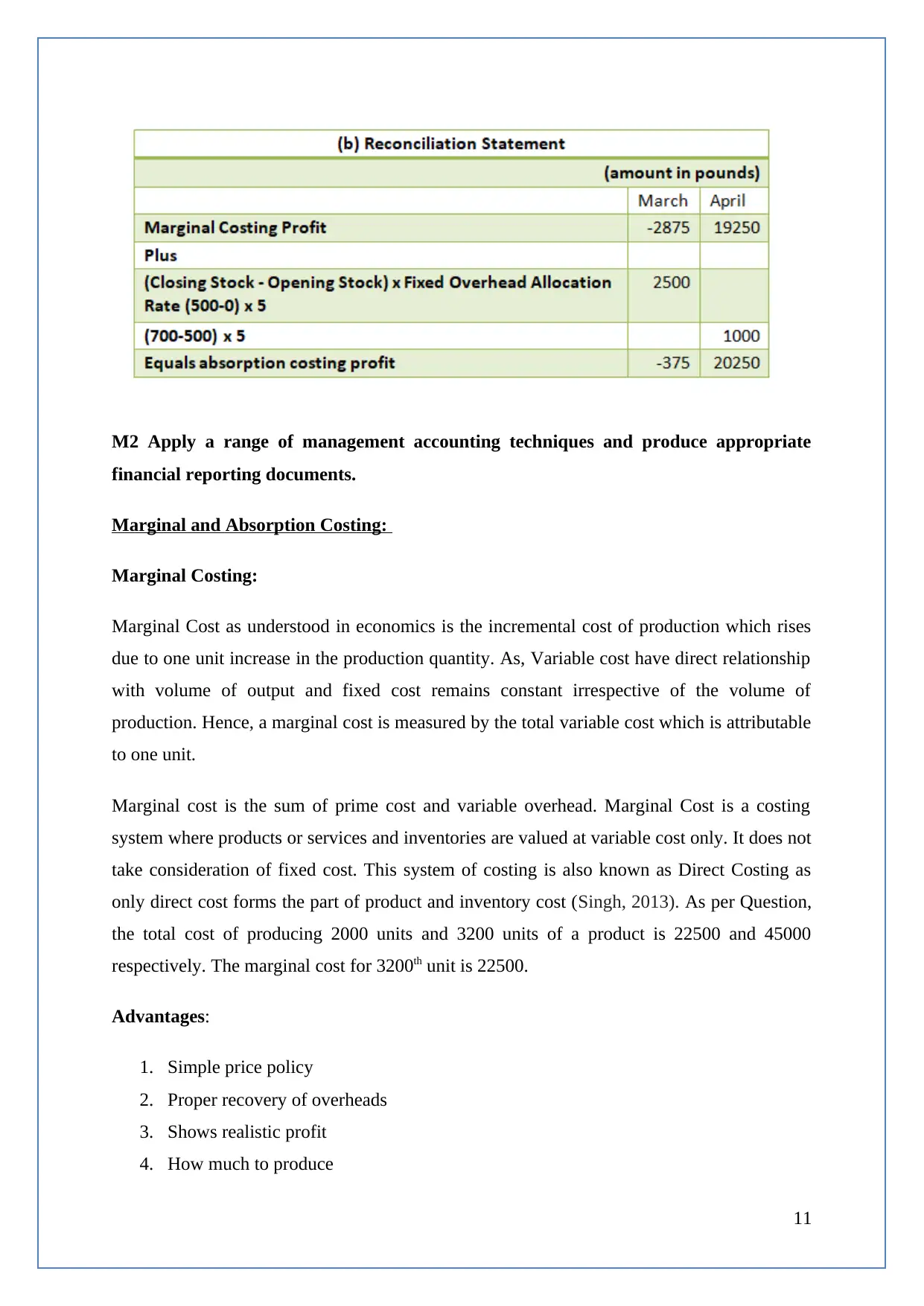
M2 Apply a range of management accounting techniques and produce appropriate
financial reporting documents.
Marginal and Absorption Costing:
Marginal Costing:
Marginal Cost as understood in economics is the incremental cost of production which rises
due to one unit increase in the production quantity. As, Variable cost have direct relationship
with volume of output and fixed cost remains constant irrespective of the volume of
production. Hence, a marginal cost is measured by the total variable cost which is attributable
to one unit.
Marginal cost is the sum of prime cost and variable overhead. Marginal Cost is a costing
system where products or services and inventories are valued at variable cost only. It does not
take consideration of fixed cost. This system of costing is also known as Direct Costing as
only direct cost forms the part of product and inventory cost (Singh, 2013). As per Question,
the total cost of producing 2000 units and 3200 units of a product is 22500 and 45000
respectively. The marginal cost for 3200th unit is 22500.
Advantages:
1. Simple price policy
2. Proper recovery of overheads
3. Shows realistic profit
4. How much to produce
11
financial reporting documents.
Marginal and Absorption Costing:
Marginal Costing:
Marginal Cost as understood in economics is the incremental cost of production which rises
due to one unit increase in the production quantity. As, Variable cost have direct relationship
with volume of output and fixed cost remains constant irrespective of the volume of
production. Hence, a marginal cost is measured by the total variable cost which is attributable
to one unit.
Marginal cost is the sum of prime cost and variable overhead. Marginal Cost is a costing
system where products or services and inventories are valued at variable cost only. It does not
take consideration of fixed cost. This system of costing is also known as Direct Costing as
only direct cost forms the part of product and inventory cost (Singh, 2013). As per Question,
the total cost of producing 2000 units and 3200 units of a product is 22500 and 45000
respectively. The marginal cost for 3200th unit is 22500.
Advantages:
1. Simple price policy
2. Proper recovery of overheads
3. Shows realistic profit
4. How much to produce
11
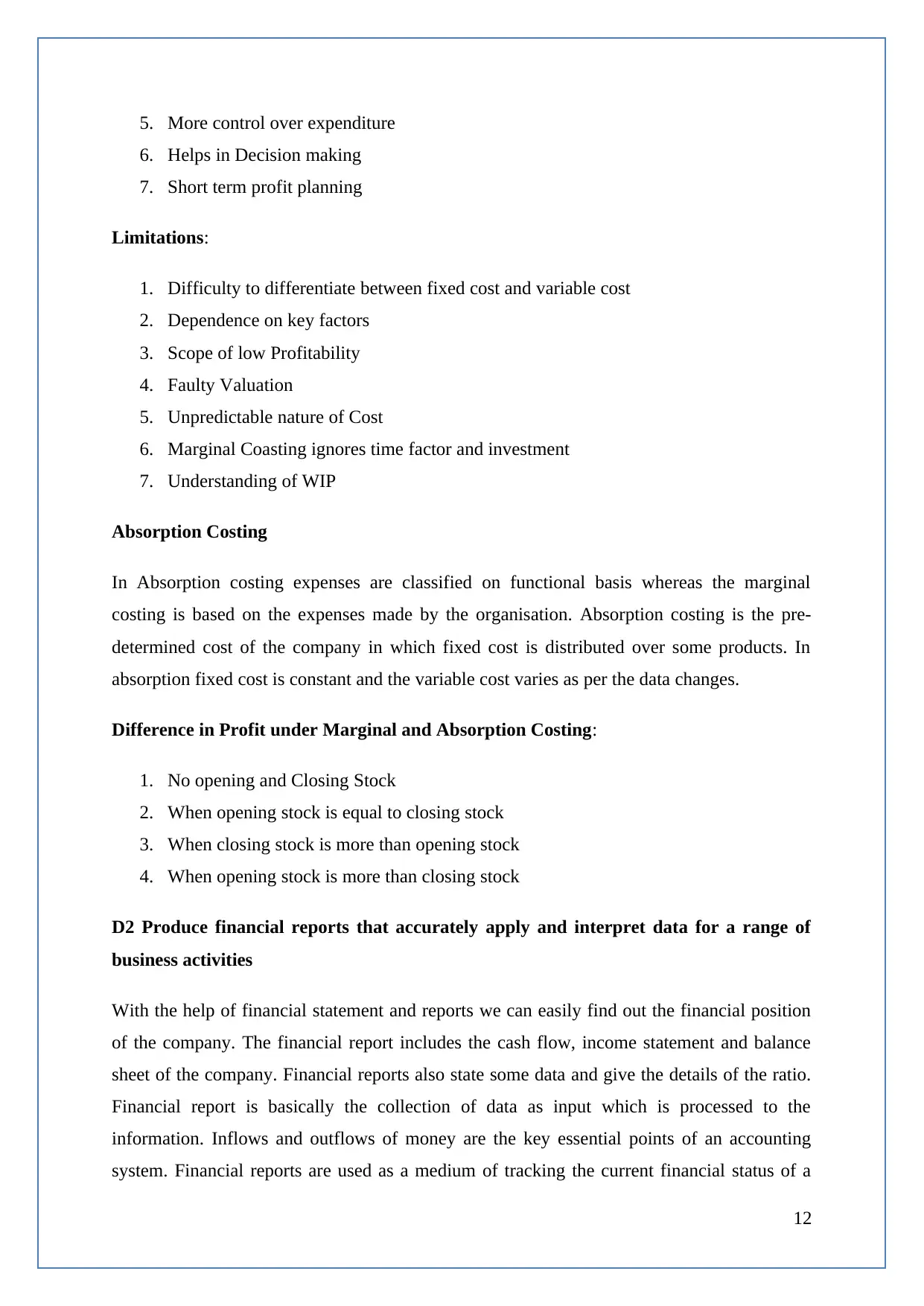
5. More control over expenditure
6. Helps in Decision making
7. Short term profit planning
Limitations:
1. Difficulty to differentiate between fixed cost and variable cost
2. Dependence on key factors
3. Scope of low Profitability
4. Faulty Valuation
5. Unpredictable nature of Cost
6. Marginal Coasting ignores time factor and investment
7. Understanding of WIP
Absorption Costing
In Absorption costing expenses are classified on functional basis whereas the marginal
costing is based on the expenses made by the organisation. Absorption costing is the pre-
determined cost of the company in which fixed cost is distributed over some products. In
absorption fixed cost is constant and the variable cost varies as per the data changes.
Difference in Profit under Marginal and Absorption Costing:
1. No opening and Closing Stock
2. When opening stock is equal to closing stock
3. When closing stock is more than opening stock
4. When opening stock is more than closing stock
D2 Produce financial reports that accurately apply and interpret data for a range of
business activities
With the help of financial statement and reports we can easily find out the financial position
of the company. The financial report includes the cash flow, income statement and balance
sheet of the company. Financial reports also state some data and give the details of the ratio.
Financial report is basically the collection of data as input which is processed to the
information. Inflows and outflows of money are the key essential points of an accounting
system. Financial reports are used as a medium of tracking the current financial status of a
12
6. Helps in Decision making
7. Short term profit planning
Limitations:
1. Difficulty to differentiate between fixed cost and variable cost
2. Dependence on key factors
3. Scope of low Profitability
4. Faulty Valuation
5. Unpredictable nature of Cost
6. Marginal Coasting ignores time factor and investment
7. Understanding of WIP
Absorption Costing
In Absorption costing expenses are classified on functional basis whereas the marginal
costing is based on the expenses made by the organisation. Absorption costing is the pre-
determined cost of the company in which fixed cost is distributed over some products. In
absorption fixed cost is constant and the variable cost varies as per the data changes.
Difference in Profit under Marginal and Absorption Costing:
1. No opening and Closing Stock
2. When opening stock is equal to closing stock
3. When closing stock is more than opening stock
4. When opening stock is more than closing stock
D2 Produce financial reports that accurately apply and interpret data for a range of
business activities
With the help of financial statement and reports we can easily find out the financial position
of the company. The financial report includes the cash flow, income statement and balance
sheet of the company. Financial reports also state some data and give the details of the ratio.
Financial report is basically the collection of data as input which is processed to the
information. Inflows and outflows of money are the key essential points of an accounting
system. Financial reports are used as a medium of tracking the current financial status of a
12
⊘ This is a preview!⊘
Do you want full access?
Subscribe today to unlock all pages.

Trusted by 1+ million students worldwide
1 out of 18
Related Documents
Your All-in-One AI-Powered Toolkit for Academic Success.
+13062052269
info@desklib.com
Available 24*7 on WhatsApp / Email
![[object Object]](/_next/static/media/star-bottom.7253800d.svg)
Unlock your academic potential
Copyright © 2020–2025 A2Z Services. All Rights Reserved. Developed and managed by ZUCOL.





